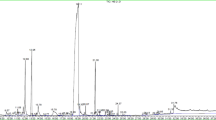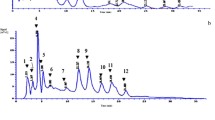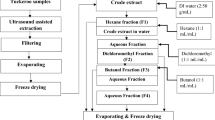Abstract
Thymbra capitata and Thymus species are commonly known as thyme in Spain and they are currently used as culinary herbs, as well as for ornamental, aromatizing and traditional medicinal purposes. Given the economic importance of thyme oils, many thyme species have been studied, and their essential oils (EOs) and other volatile-containing extracts have been chemically characterized. The aim of this study was to evaluate the antioxidant, antimicrobial and cytotoxic activities as well as the phytochemical composition of the EOs from fruits and flowers of T. capitata and Thymus species. High antioxidant capacity has been observed and related to the relative amounts of terpenoid and phenolic with good antioxidant properties. The antioxidant activities decreased as follows: TAC > TZ > TC > TM. The results of antimicrobial activity showed that all tested EOs were active against all tested microbial species, including Gram-positive and negative bacteria. The minimum inhibition concentration values obtained ranged from 0.1 to 0.01 μL/mL. Furthermore, all EOs assayed induced cell death in both human epitheloid cervix carcinoma and histiocytic leukemia cell lines. Overall, the results of this study indicates that the EOs from fruits and flowers of T. capitata and Thymus species posses interesting antioxidant properties and represent a potential source of medicine for the treatment of infectious diseases and cancer.



Similar content being viewed by others
References
Abbaszadeh S, Sharifzadeh A, Shokri H et al (2014) Antifungal efficacy of thymol, carvacrol, eugenol and menthol as alternative agents to control the growth of food-relevant fungi. J Mycol Médicale/J Med Mycol 24:e51–e56. doi:10.1016/j.mycmed.2014.01.063
Amensour M, Sendra E, Abrini J et al (2009) Total phenolic content and antioxidant activity of myrtle (Myrtus communis) extracts. Nat Prod Commun 4:819–824
Amorati R, Foti MC, Valgimigli L (2013) Antioxidant activity of essential oils. J Agric Food Chem 61:10835–10847. doi:10.1021/jf403496k
Bruneton J (2001) Aceites esenciales. Factores de variabilidad de los aceites esenciales. In: Bruneton J (ed) Farmacognosia. Acribia S.A., Zaragoza, pp. 488–491
Cano A, Acosta M, Arnao MB (2000) A method to measure antioxidant activity in organic media: application to lipophilic vitamins. Redox Rep 5:365–370. doi:10.1179/135100000101535933
Council of Europe (1997) European pharmacopoeia, 3rd edn. Council of Europe, Strasbourg
de Sousa JP, de Oliveira KÁR, de Figueiredo RCBQ, de Souza EL (2015) Influence of carvacrol and 1,8-cineole on cell viability, membrane integrity, and morphology of aeromonas hydrophila cultivated in a vegetable-based broth. J Food Prot 78:424–429. doi:10.4315/0362-028X.JFP-14-242
Deb DD, Parimala G, Saravana Devi S, Chakraborty T (2011) Effect of thymol on peripheral blood mononuclear cell PBMC and acute promyelotic cancer cell line HL-60. Chem Biol Interact 193:97–106. doi:10.1016/j.cbi.2011.05.009
Delgado Adámez J, Gamero Samino E, Valdés Sánchez E, González-Gómez D (2012) In vitro estimation of the antibacterial activity and antioxidant capacity of aqueous extracts from grape-seeds (Vitis vinifera L.). Food Control 24:136–141. doi:10.1016/j.foodcont.2011.09.016
Döll-Boscardin PM, Sartoratto A, Sales Maia BH et al (2012) In vitro cytotoxic potential of essential oils of Eucalyptus benthamii and its related terpenes on tumor cell lines. Evid Based Complement Alternat Med 2012:1–8. doi:10.1155/2012/342652
Dorman HJD, Surai P, Deans SG (2000) In vitro antioxidant activity of a number of plant essential oils and phytoconstituents. J Essent Oil Res 12:241–248
Ehrnhöfer-Ressler MM, Fricke K, Pignitter M et al (2013) Identification of 1,8-cineole, borneol, camphor, and thujone as anti-inflammatory compounds in a Salvia officinalis L. infusion using human gingival fibroblasts. J Agric Food Chem 61:3451–3459. doi:10.1021/jf305472t
Figueiredo AC, Barroso JG, Pedro LG (2010) Volatiles from Thymbra and Thymus species of the western mediterranean basin, portugal and macaronesia. Nat Prod Commun 5:1465–1476
Gilles M, Zhao J, An M, Agboola S (2010) Chemical composition and antimicrobial properties of essential oils of three Australian Eucalyptus species. Food Chem 119:731–737. doi:10.1016/j.foodchem.2009.07.021
Gonçalves MJ, Cruz MT, Cavaleiro C et al (2010) Chemical, antifungal and cytotoxic evaluation of the essential oil of Thymus zygis subsp. sylvestris. Ind Crops Prod 32:70–75. doi:10.1016/j.indcrop.2010.03.005
Heim KE, Tagliaferro AR, Bobilya DJ (2002) Flavonoid antioxidants: chemistry, metabolism and structure-activity relationships. J Nutr Biochem 13:572–584
Hosseini Behbahani M, Ghasemi Y, Khoshnoud MJ et al (2013) Volatile oil composition and antimicrobial activity of two Thymus species. Pharmacogn J 5:77–79. doi:10.1016/j.phcgj.2012.09.002
Jaberian H, Piri K, Nazari J (2013) Phytochemical composition and in vitro antimicrobial and antioxidant activities of some medicinal plants. Food Chem 136:237–244. doi:10.1016/j.foodchem.2012.07.084
Jayakumar S, Madankumar A, Asokkumar S et al (2012) Potential preventive effect of carvacrol against diethylnitrosamine-induced hepatocellular carcinoma in rats. Mol Cell Biochem 360:51–60. doi:10.1007/s11010-011-1043-7
Klein G, Rüben C, Upmann M (2013) Antimicrobial activity of essential oil components against potential food spoilage microorganisms. Curr Microbiol 67:200–208. doi:10.1007/s00284-013-0354-1
Kumar D, Rawat DS (2013) Synthesis and antioxidant activity of thymol and carvacrol based Schiff bases. Bioorg Med Chem Lett 23:641–645. doi:10.1016/j.bmcl.2012.12.001
Kumar P, Mishra S, Malik A, Satya S (2013) Housefly (Musca domestica L.) control potential of Cymbopogon citratus Stapf. (Poales: Poaceae) essential oil and monoterpenes (citral and 1,8-cineole). Parasitol Res 112:69–76. doi:10.1007/s00436-012-3105-5
Limem-Ben Amor I, Neffati A, Ben Sgaier M et al (2008) Antimicrobial activity of essential oils isolated from Phlomis crinita Cav. ssp. mauritanica Munby. J Am Oil Chem Soc 85:845–849. doi:10.1007/s11746-008-1272-4
Marchese A, Orhan IE, Daglia M et al (2016) Antibacterial and antifungal activities of thymol: a brief review of the literature. Food Chem 210:402–414. doi:10.1016/j.foodchem.2016.04.111
Mateos S, Valls J, Nadal M, Arola L (2001) Estudio de madurez fenólica sobre diferentes variedades tintas y su relación con el color de los vinos. Tecnología del Vino 2:45–50
Miguel MG (2010a) Antioxidant activity of medicinal and aromatic plants. A review. Flavour Fragr J 25:291–312. doi:10.1002/ffj.1961
Miguel MG (2010b) Antioxidant and anti-inflammatory activities of essential oils: a short review. Molecules 15:9252–9287. doi:10.3390/molecules15129252
Miguel G, Guerrero C, Rodrigues H et al (1999) Study of the substrate and fertilization effects on the production of essentials oils by Thymus mastichina (L.) L. ssp. mastichina cultivated in pots. In: Anaç D, Martin-Prével P (eds) Improved crop quality by nutrient management. Springer, Dordrecht, pp 201–204
Miguel G, Simões M, Figueiredo AC et al (2004) Composition and antioxidant activities of the essential oils of Thymus caespititius, Thymus camphoratus and Thymus mastichina. Food Chem 86:183–188. doi:10.1016/j.foodchem.2003.08.031
Mosmann T (1983) Rapid colorimetric assay for cellular growth and survival: application to proliferation and cytotoxicity assays. J Immunol Methods 65:55–63
Nazzaro F, Fratianni F, De Martino L et al (2013) Effect of essential oils on pathogenic bacteria. Pharmaceuticals 6:1451–1474. doi:10.3390/ph6121451
Pinelo M, Rubilar M, Jerez M et al (2005) Effect of solvent, temperature, and solvent-to-solid ratio on the total phenolic content and antiradical activity of extracts from different components of grape pomace. J Agric Food Chem 53:2111–2117. doi:10.1021/jf0488110
Quiroga PR, Asensio CM, Nepote V (2015) Antioxidant effects of the monoterpenes carvacrol, thymol and sabinene hydrate on chemical and sensory stability of roasted sunflower seeds. J Sci Food Agric 95:471–479. doi:10.1002/jsfa.6744
Ruberto G, Baratta MT (2000) Antioxidant activity of selected essential oil components in two lipid model systems. Food Chem 69:167–174. doi:10.1016/S0308-8146(99)00247-2
Vilela GR, de Almeida GS, D’Arce MABR et al (2009) Activity of essential oil and its major compound, 1,8-cineole, from Eucalyptus globulus Labill., against the storage fungi Aspergillus flavus Link and Aspergillus parasiticus Speare. J Stored Prod Res 45:108–111. doi:10.1016/j.jspr.2008.10.006
Viuda-Martos M, Mohamady MA, Fernández-López J et al (2011) In vitro antioxidant and antibacterial activities of essentials oils obtained from Egyptian aromatic plants. Food Control 22:1715–1722. doi:10.1016/j.foodcont.2011.04.003
Acknowledgements
J. Espino and M. Garrido hold a research post-doctoral fellowship from Government of Extremadura (jointly financed by the European Regional Development Fund (ERDF); Refs. PO14011 and PO14013, respectively).
Author information
Authors and Affiliations
Corresponding author
Ethics declarations
Conflict of interest
There are no conflicts of interest to disclose.
Rights and permissions
About this article
Cite this article
Delgado-Adámez, J., Garrido, M., Bote, M.E. et al. Chemical composition and bioactivity of essential oils from flower and fruit of Thymbra capitata and Thymus species. J Food Sci Technol 54, 1857–1865 (2017). https://doi.org/10.1007/s13197-017-2617-5
Revised:
Accepted:
Published:
Issue Date:
DOI: https://doi.org/10.1007/s13197-017-2617-5




